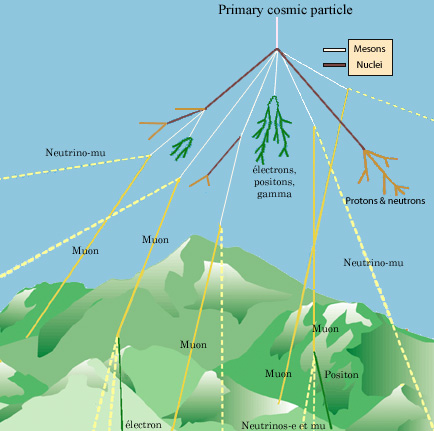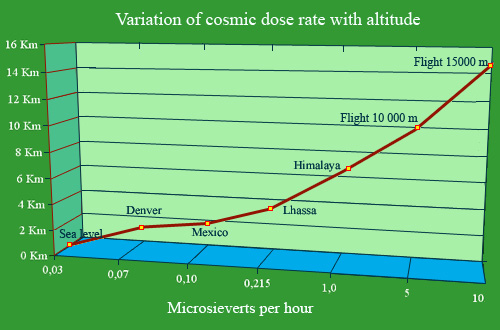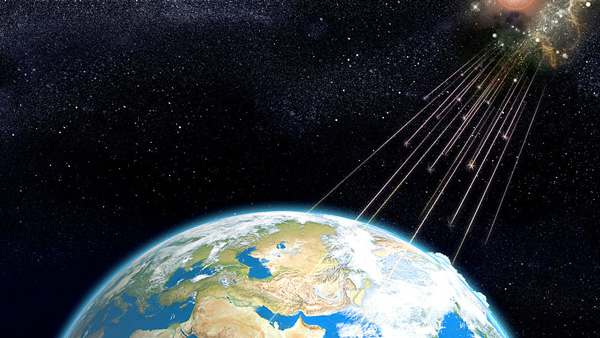A permanent shelling of the Earth’s atmosphere

A shower of particles
Primary cosmic particles travel enormous distances before they collide with the Earth. They are stable particles, such as protons, light nuclei, gamma rays or even electrons. If they have enough energy, their initial collision can spark off a chain reaction, resulting in the formation of a shower of particles. Some of these, such as the mesons, are extremely short lived whereas others, such as muons, live long enough to reach the ground. These chain reactions produce also several types of neutrinos.
© IN2P3
The Earth is constantly being bombarded by very energetic particles coming from the furthest reaches of our galaxy and even beyond. These cosmic rays have very different energies and can be created in a vast number of ways.
The majority of the cosmic rays we get on Earth come from the Sun, the explosion of stars (supernovae), pulsars and others remote galactic sources. When primary cosmic rays collide with the nuclei in the atmosphere, they give rise to a shower of secondary particles charged and neutrals. Among the charged particles are muons, unstable parents of the electron, able to long runs in the atmosphere. Secondary particles may reach the ground. In this way hundreds of these particles pass through our bodies every second, although the number increases with altitude. The further away you are from the Earth surface, the less effective the Earth’s magnetic shield.

Effect of altitude
The rate of exposure to cosmic rays, represented here in microsieverts (millionths of a sievert) per hour, increases with altitude. For purposes of comparison, the average dose of natural radioactivity absorbed in one year is 2400 microsieverts.
© IN2P3
The highest doses are therefore absorbed by astronauts in space flights, who may be exposed to an excess of 1 mSv per day. Plane flights at an altitude of 8,000 metres expose their passengers to a dose rate a hundred times greater than that felt at sea level, but only during a few hours : A passenger travelling from London to New York would only receive a dose of 0.032 mSv – the equivalent of a dental X-ray. The numbers being discussed are tiny, but the doses absorbed by frequent flyers and in-flight crew should be carefully monitored.
Secondary cosmic particles are not the product of radioactive decays. Nevertheless, they are the source of exposure to radiation when they reach the surface of the Earth. The flux of these cosmic particles is approximately 240 per metre squared per second at ground level. Many pass through our bodies every second.
In addition, 65 billion neutrinos pass through every square centimeter of our skin every second as if we were transparent. Neutrinos interact so little that among 100,000 billion solar neutrinos passing through the Earth, one or less than one less than one interacts or be stopped!
Without the Earth magnetic field, however, these fluxes would be far greater, as radiation levels double at 1,500 metres above sea level and increase still further the higher one goes. Even without getting on a plane we are still exposed to radiation which vary greatly from place to place. For the first few kilometres of the atmosphere, the exposure doubles approximately every 1,500 metres. Those living in the Andes or the Himalayas, therefore, are exposed to four times as much cosmic radiations as the inhabitants of Paris, London or New York.
The annual exposure to cosmic radiations at sea level is roughly 0.27 mSv, a figure which takes into account the protection offered by buildings. The average dose absorbed by an individual is extremely hard to calculate, given the large number of factors which are involved. In France, this figure has been calculated at around 0.30 mSv per year.
The constant shelling of the atmosphere also results in the production of small quantities of radioactive atoms. Carbon 14, for instance, is created when cosmic rays interact with atoms of nitrogen.

Huge telescopes in the Namibian desert
Cosmic gamma rays collide with the Earth day and night, but the elusive sparks of Cherenkov light they give off can only be observed on moonless nights far away from human habitation. This large telescope forms part of the HESS experiment, and is waiting for the sunset on the Namibian plains to start recording data. It is when the four telescopes simultaneously record the same spark that the cosmic gamma ray direction can be accurately determined.
© HESS/LPNHE
The annual exposure to cosmic radiations at sea level is roughly 0.27 mSv, a figure which takes into account the protection offered by buildings. The average dose absorbed by an individual is extremely hard to calculate, given the large number of factors which are involved. In France, this figure has been calculated at around 0.30 mSv per year.
The constant shelling of the atmosphere also results in the production of small quantities of radioactive atoms. Carbon 14, for instance, is created when cosmic rays interact with atoms of nitrogen.

Very high energy cosmic particles
Very high energy particles coming from our galaxy and remote galaxies reach the Earth. They are studied by ground on the ground or onboard satellites experiments. When they hit the upper layers of the atmosphere, they generate cosmic showers. Although these showers do not have the size drawn by the artist, their detection requires ground devices occupying considerable area as in the case the HESS experiment. Même si ces gerbes n’ont pas l’ampleur de celle dessinée par l’artiste, leur détection au sol nécessite des dispositifs occupant une surface considérable comme ceux de l’expérience
© HESS.Cosmic rays – 100 years of discovery
The study of cosmic rays and astroparticles
The origin of cosmic rays has been a major topic of research since their discovery by Victor Hess in 1912. The study of high-energy cosmic showers provides unvaluable information on the origin of particles created in our galaxy or more distant galaxies, accelerated during the most violent phenomena in the Universe, sometimes reaching the Earth after a several billion years journey. Such is the purpose of Astroparticles, a new discipline of astronomy rapidly developing in recent years.